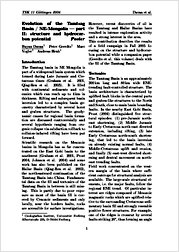Evolution of the Tamtsag Basin / NE-Mongolia — part II: structure and hydrocarbon potential
Davaa, Buyan
Geerdts, Peter
Vogler, Marc
Henk, Andreas
Universitätsverlag Göttingen
Sammelband- / Konferenzbeitrag
Verlagsversion
Deutsch
Davaa, Buyan; Geerdts, Peter; Vogler, Marc; Henk, Andreas, 2006: Evolution of the Tamtsag Basin / NE-Mongolia — part II: structure and hydrocarbon potential. In: Philipp, S.; Leiss, B; Vollbrecht, A.; Tanner, D.; Gudmundsson, A. (eds.): 11. Symposium "Tektonik, Struktur- und Kristallingeologie"; 2006, Univ.-Verl. Göttingen, S. 34 - 36., , DOI: 10.23689/fidgeo-1900.
 |
Dokument öffnen: |
The Tamtsag basin in NE Mongolia is
part of a widespread basin system which
formed during Late Jurassic and Cretaceous
times (Graham et al. 2001,
Qing-Ren et al. 2003). It is filled
with continental sediments and volcanics
which can reach up to 4km in
thickness. Rifting and subsequent basin
inversion led to a complex basin geometry
characterized by several horst
and graben structures. The geodynamic
causes for regional basin formation
are discussed controversially and
several hypothesis ranging from orogenic
collapse via subduction rollback to
collision-induced rifting have been put
forward.
Scientific research on the Mesozoic
basins in Mongolia has so far concentrated
on the East Gobi basin to the
southwest (Graham et al. 2001, Prost
2004, Johnson et al. 2004) and some
work has also been published on the
Hailar Basin (Qing-Ren et al. 2003),
the northeastward continuation of the
Tamtsag Basin into China. Fundamental
data on the fill and tectonics of the
Tamtsag Basin in between is still missing.
This is partly due to poor exposure
as most of the basin fill is covered
by Cenozoic sediments and only
locally, near the borders faults, rocks
are accessible for surface investigations.
However, recent discoveries of oil in
the Tamtsag and Hailar Basins have
resulted in intense exploration activity
and a strong interest in the area.
This contribution describes the results
of a field campaign in Fall 2005 focusing
on the structure and hydrocarbon
potential while a companion paper
(Geerdts et al. this volume) deals with
the fill of the Tamtsag Basin.
Statistik:
ZugriffsstatistikSchlagworte:
Mongolei <Nordost>Riftsystem
Mesozoikum
Sedimentationsbecken
Tektonik
Erdölvorkommen
Sedimentationsbecken als Erdkrustentypen {Geologie}
Rifts {Geologie}
Mongolei (Mongolische Volksrepublik) {Geologie}
Vorratsberechnungen {Kohlenwasserstofflagerstätten}
Zentralasien {Fossile Energieträger}

